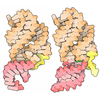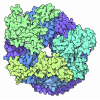+ Open data
Open data
- Basic information
Basic information
| Entry | Database: PDB / ID: 8bgu | ||||||||||||
|---|---|---|---|---|---|---|---|---|---|---|---|---|---|
| Title | human MDM2-5S RNP | ||||||||||||
 Components Components |
| ||||||||||||
 Keywords Keywords | RNA BINDING PROTEIN / 5S RNP / Mdm2 | ||||||||||||
| Function / homology |  Function and homology information Function and homology informationcellular response to vitamin B1 / response to formaldehyde / response to water-immersion restraint stress / response to ether / traversing start control point of mitotic cell cycle / atrial septum development / regulation of protein catabolic process at postsynapse, modulating synaptic transmission / fibroblast activation / Trafficking of AMPA receptors / receptor serine/threonine kinase binding ...cellular response to vitamin B1 / response to formaldehyde / response to water-immersion restraint stress / response to ether / traversing start control point of mitotic cell cycle / atrial septum development / regulation of protein catabolic process at postsynapse, modulating synaptic transmission / fibroblast activation / Trafficking of AMPA receptors / receptor serine/threonine kinase binding / negative regulation of protein neddylation / peroxisome proliferator activated receptor binding / negative regulation of intrinsic apoptotic signaling pathway by p53 class mediator / positive regulation of vascular associated smooth muscle cell migration / negative regulation of protein processing / SUMO transferase activity / response to steroid hormone / NEDD8 ligase activity / AKT phosphorylates targets in the cytosol / response to iron ion / atrioventricular valve morphogenesis / endocardial cushion morphogenesis / cellular response to peptide hormone stimulus / ventricular septum development / negative regulation of ubiquitin protein ligase activity / positive regulation of muscle cell differentiation / cardiac septum morphogenesis / regulation of postsynaptic neurotransmitter receptor internalization / blood vessel development / SUMOylation of ubiquitinylation proteins / ligase activity / cellular response to alkaloid / Constitutive Signaling by AKT1 E17K in Cancer / regulation of protein catabolic process / negative regulation of signal transduction by p53 class mediator / negative regulation of DNA damage response, signal transduction by p53 class mediator / SUMOylation of transcription factors / Peptide chain elongation / Selenocysteine synthesis / Formation of a pool of free 40S subunits / response to magnesium ion / cellular response to UV-C / Eukaryotic Translation Termination / protein sumoylation / ubiquitin ligase inhibitor activity / cellular response to actinomycin D / Response of EIF2AK4 (GCN2) to amino acid deficiency / SRP-dependent cotranslational protein targeting to membrane / negative regulation of ubiquitin-dependent protein catabolic process / positive regulation of signal transduction by p53 class mediator / Viral mRNA Translation / blood vessel remodeling / cellular response to estrogen stimulus / Nonsense Mediated Decay (NMD) independent of the Exon Junction Complex (EJC) / GTP hydrolysis and joining of the 60S ribosomal subunit / protein localization to nucleus / L13a-mediated translational silencing of Ceruloplasmin expression / positive regulation of protein binding / Major pathway of rRNA processing in the nucleolus and cytosol / ribonucleoprotein complex binding / protein targeting / Nonsense Mediated Decay (NMD) enhanced by the Exon Junction Complex (EJC) / protein autoubiquitination / positive regulation of vascular associated smooth muscle cell proliferation / NPAS4 regulates expression of target genes / negative regulation of proteasomal ubiquitin-dependent protein catabolic process / transcription repressor complex / cytosolic ribosome / positive regulation of mitotic cell cycle / regulation of heart rate / proteolysis involved in protein catabolic process / positive regulation of translation / regulation of signal transduction by p53 class mediator / positive regulation of protein export from nucleus / ribosomal large subunit biogenesis / ubiquitin binding / mRNA 3'-UTR binding / response to cocaine / DNA damage response, signal transduction by p53 class mediator / Stabilization of p53 / establishment of protein localization / Regulation of RUNX3 expression and activity / cellular response to gamma radiation / Oncogene Induced Senescence / RING-type E3 ubiquitin transferase / protein destabilization / Regulation of TP53 Activity through Methylation / mRNA 5'-UTR binding / cellular response to growth factor stimulus / response to toxic substance / centriolar satellite / Regulation of expression of SLITs and ROBOs / cellular response to hydrogen peroxide / protein polyubiquitination / rRNA processing / ubiquitin-protein transferase activity / disordered domain specific binding / endocytic vesicle membrane / p53 binding / ubiquitin protein ligase activity Similarity search - Function | ||||||||||||
| Biological species |  Homo sapiens (human) Homo sapiens (human) | ||||||||||||
| Method | ELECTRON MICROSCOPY / single particle reconstruction / cryo EM / Resolution: 4.1 Å | ||||||||||||
 Authors Authors | Castillo, N. / Thoms, M. / Flemming, D. / Hammaren, H.M. / Buschauer, R. / Ameismeier, M. / Bassler, J. / Beck, M. / Beckmann, R. / Hurt, E. | ||||||||||||
| Funding support |  Germany, European Union, 3items Germany, European Union, 3items
| ||||||||||||
 Citation Citation |  Journal: Nat Struct Mol Biol / Year: 2023 Journal: Nat Struct Mol Biol / Year: 2023Title: Structure of nascent 5S RNPs at the crossroad between ribosome assembly and MDM2-p53 pathways. Authors: Nestor Miguel Castillo Duque de Estrada / Matthias Thoms / Dirk Flemming / Henrik M Hammaren / Robert Buschauer / Michael Ameismeier / Jochen Baßler / Martin Beck / Roland Beckmann / Ed Hurt /  Abstract: The 5S ribonucleoprotein (RNP) is assembled from its three components (5S rRNA, Rpl5/uL18 and Rpl11/uL5) before being incorporated into the pre-60S subunit. However, when ribosome synthesis is ...The 5S ribonucleoprotein (RNP) is assembled from its three components (5S rRNA, Rpl5/uL18 and Rpl11/uL5) before being incorporated into the pre-60S subunit. However, when ribosome synthesis is disturbed, a free 5S RNP can enter the MDM2-p53 pathway to regulate cell cycle and apoptotic signaling. Here we reconstitute and determine the cryo-electron microscopy structure of the conserved hexameric 5S RNP with fungal or human factors. This reveals how the nascent 5S rRNA associates with the initial nuclear import complex Syo1-uL18-uL5 and, upon further recruitment of the nucleolar factors Rpf2 and Rrs1, develops into the 5S RNP precursor that can assemble into the pre-ribosome. In addition, we elucidate the structure of another 5S RNP intermediate, carrying the human ubiquitin ligase Mdm2, which unravels how this enzyme can be sequestered from its target substrate p53. Our data provide molecular insight into how the 5S RNP can mediate between ribosome biogenesis and cell proliferation. | ||||||||||||
| History |
|
- Structure visualization
Structure visualization
| Structure viewer | Molecule:  Molmil Molmil Jmol/JSmol Jmol/JSmol |
|---|
- Downloads & links
Downloads & links
- Download
Download
| PDBx/mmCIF format |  8bgu.cif.gz 8bgu.cif.gz | 147.1 KB | Display |  PDBx/mmCIF format PDBx/mmCIF format |
|---|---|---|---|---|
| PDB format |  pdb8bgu.ent.gz pdb8bgu.ent.gz | 93.9 KB | Display |  PDB format PDB format |
| PDBx/mmJSON format |  8bgu.json.gz 8bgu.json.gz | Tree view |  PDBx/mmJSON format PDBx/mmJSON format | |
| Others |  Other downloads Other downloads |
-Validation report
| Summary document |  8bgu_validation.pdf.gz 8bgu_validation.pdf.gz | 943.8 KB | Display |  wwPDB validaton report wwPDB validaton report |
|---|---|---|---|---|
| Full document |  8bgu_full_validation.pdf.gz 8bgu_full_validation.pdf.gz | 949.5 KB | Display | |
| Data in XML |  8bgu_validation.xml.gz 8bgu_validation.xml.gz | 24.2 KB | Display | |
| Data in CIF |  8bgu_validation.cif.gz 8bgu_validation.cif.gz | 35.6 KB | Display | |
| Arichive directory |  https://data.pdbj.org/pub/pdb/validation_reports/bg/8bgu https://data.pdbj.org/pub/pdb/validation_reports/bg/8bgu ftp://data.pdbj.org/pub/pdb/validation_reports/bg/8bgu ftp://data.pdbj.org/pub/pdb/validation_reports/bg/8bgu | HTTPS FTP |
-Related structure data
| Related structure data |  16036MC  7ozsC M: map data used to model this data C: citing same article ( |
|---|---|
| Similar structure data | Similarity search - Function & homology  F&H Search F&H Search |
- Links
Links
- Assembly
Assembly
| Deposited unit | 
|
|---|---|
| 1 |
|
- Components
Components
| #1: Protein | Mass: 55293.758 Da / Num. of mol.: 1 Source method: isolated from a genetically manipulated source Source: (gene. exp.)  Homo sapiens (human) / Gene: MDM2 / Production host: Homo sapiens (human) / Gene: MDM2 / Production host:  References: UniProt: Q00987, RING-type E3 ubiquitin transferase |
|---|---|
| #2: RNA chain | Mass: 38951.105 Da / Num. of mol.: 1 / Source method: isolated from a natural source / Source: (natural)  |
| #3: Protein | Mass: 34426.789 Da / Num. of mol.: 1 Source method: isolated from a genetically manipulated source Source: (gene. exp.)  Homo sapiens (human) / Gene: RPL5, MSTP030 / Production host: Homo sapiens (human) / Gene: RPL5, MSTP030 / Production host:  |
| #4: Protein | Mass: 20288.465 Da / Num. of mol.: 1 Source method: isolated from a genetically manipulated source Source: (gene. exp.)  Homo sapiens (human) / Gene: RPL11 / Production host: Homo sapiens (human) / Gene: RPL11 / Production host:  |
| #5: Chemical | ChemComp-ZN / |
| Has ligand of interest | Y |
-Experimental details
-Experiment
| Experiment | Method: ELECTRON MICROSCOPY |
|---|---|
| EM experiment | Aggregation state: PARTICLE / 3D reconstruction method: single particle reconstruction |
- Sample preparation
Sample preparation
| Component | Name: human MDM2-5S RNP / Type: COMPLEX / Entity ID: #1-#4 / Source: RECOMBINANT |
|---|---|
| Source (natural) | Organism:  Homo sapiens (human) Homo sapiens (human) |
| Source (recombinant) | Organism:  |
| Buffer solution | pH: 7.5 |
| Specimen | Embedding applied: NO / Shadowing applied: NO / Staining applied: NO / Vitrification applied: YES |
| Specimen support | Grid material: GOLD |
| Vitrification | Cryogen name: ETHANE |
- Electron microscopy imaging
Electron microscopy imaging
| Experimental equipment |  Model: Titan Krios / Image courtesy: FEI Company |
|---|---|
| Microscopy | Model: FEI TITAN KRIOS |
| Electron gun | Electron source:  FIELD EMISSION GUN / Accelerating voltage: 300 kV / Illumination mode: SPOT SCAN FIELD EMISSION GUN / Accelerating voltage: 300 kV / Illumination mode: SPOT SCAN |
| Electron lens | Mode: BRIGHT FIELD / Nominal defocus max: 4000 nm / Nominal defocus min: 400 nm |
| Image recording | Electron dose: 38 e/Å2 / Film or detector model: GATAN K2 SUMMIT (4k x 4k) |
- Processing
Processing
| CTF correction | Type: PHASE FLIPPING AND AMPLITUDE CORRECTION |
|---|---|
| 3D reconstruction | Resolution: 4.1 Å / Resolution method: FSC 0.143 CUT-OFF / Num. of particles: 219620 / Symmetry type: POINT |
 Movie
Movie Controller
Controller







 PDBj
PDBj













































